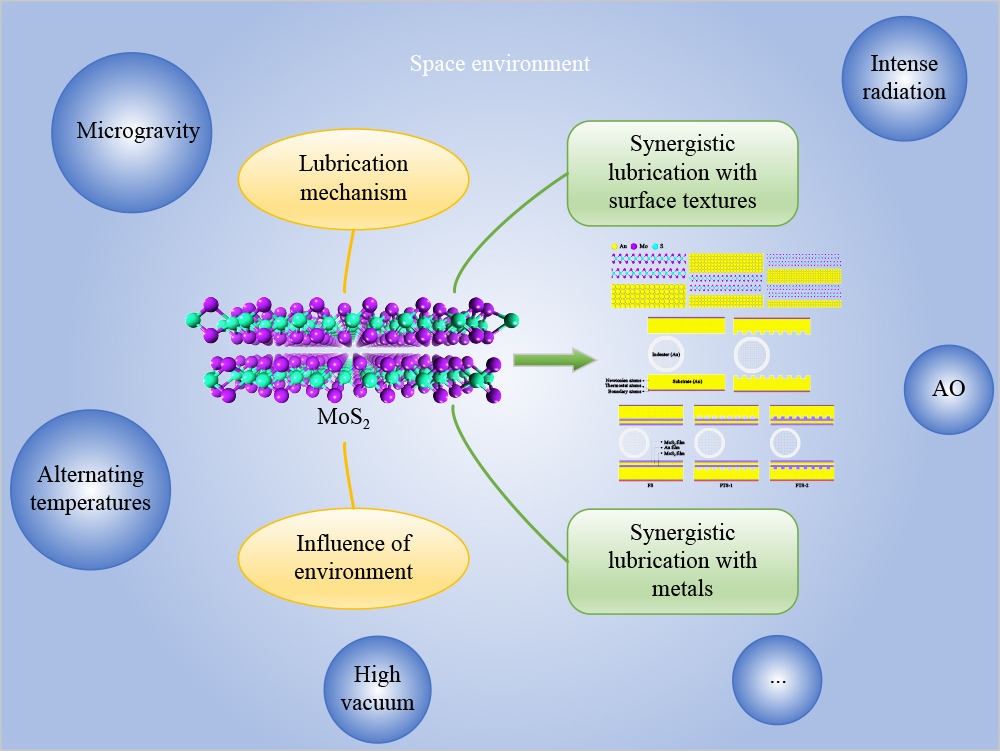1 Introduction
Tab.1 Spacecraft failures caused by the space environment [10] |
| Spacecraft | Space environment | Anomaly description |
|---|---|---|
| Hubble space telescope | Thermal | Thermal expansion of the support poles was blamed for the vibrations, which interfered with deep-space observations |
| JERS-1 | Thermal | The cold welding of the deployment pins due to faulty lubrication caused the radar antenna to fail to deploy |
| Galileo | Thermal | A lubricant used on the mechanical joints failed to function in the ambient thermal environment |
| GOES-7 | Solar | The intense high-energy radiation permanently damaged solar panel electronics and caused an accelerated power degradation |
| ETS-6 | Radiation | High radiation levels from the Van Allen belts quickly eroded the efficiency of the solar panels |
| Intelsat K | Plasma | The electrostatic discharge resulting from a geomagnetic storm disabled the momentum wheel control circuitry on the satellite |
2 Lubricants in the space environment
3 Lubrication mechanism of MoS2 and influence of the environment
3.1 Lubrication mechanism of MoS2
3.2 MoS2 in the space environment

Fig.4 (a) Lateral force of the MoS2 coating following proton irradiation to five fluences from 1019 to 3 × 1023 H/m2 and the unirradiated condition and (b) average coefficient of friction for each irradiation condition, which tends to increase with dose [9]. Reproduced with permission from Ref. [9] from Elsevier. |
3.3 MoS2 in the ground environment
3.3.1 Oxidation during storage

Fig.5 Average coefficient of friction vs. number of cycles for MoS2 coatings tested in air and ultrahigh vacuum (UHV). D refers to samples stored in 2% relative humidity for less than 100 days after deposition; H refers to storage for 150 days in 25%–35% relative humidity followed by 190 days in an atmosphere of 98% relative humidity after deposition [84]. Reproduced with permission from Ref. [84] from Elsevier. |
3.3.2 Effect of water and oxygen on operating contacts
4 Synergistic effects of MoS2 with surface textures or metals
4.1 Synergistic effect of MoS2 with surface textures
4.2 Synergistic effect of MoS2 with metals

Fig.8 Oxidation kinetic process of simulated MoS2 structures including (a) amorphous, (b) random orientation, (c) MoS2 (002) perpendicular to the substrate, and (d) MoS2 (002) parallel to the substrate under atomic oxygen (AO) irradiation [109]. Reproduced with permission from Ref. [109] from American Chemical Society. |

Fig.10 Tribological testing of the pure and codeposited MoS2 coatings. Per-cycle averaged friction coefficient under (a) ultrahigh vacuum ((2.7 ± 2.2) ×10−6 Pa), (b) humid clean room air (ISO 5 Clean Room, RH 43% ± 5%), and (c) transition from 150 cycles under air conditions followed by pumping down the chamber and 850 cycles in ultrahigh vacuum [4]. UHV: ultrahigh vacuum. Reproduced with permission from Ref. [4] from John Wiley and Sons. |

Fig.11 Scanning electron microscope images of four coatings of MoS2 + Ta, MoS2 + WC, MoS2 + Ti, and MoS2 after cycling or failure (μ > 0.5) in (a–d) ultrahigh vacuum (UHV), (e–h) air, and (i–k) transition from air to ultrahigh vacuum environments [4]. Reproduced with permission from Ref. [4] from John Wiley and Sons. |

Fig.13 Multilayer coatings with alternating hard and soft layers can allow deflection to occur under load without yielding of the hard layers. They effectively slide over each other, with shear occurring in the soft layer. The pattern of shear is illustrated by the line through the film, which was initially straight in the unloaded condition [203]. Reproduced with permission from Ref. [203] from Elsevier. |
Tab.2 Mean COF (μ) of the MoS2 pure and multilayer coatings after different numbers of revolutions in humid air (50%) for a load of 5 N [165] |
| MoS2–metal multilayer | Mean COF, μ | X-ray diffraction (XRD) (002) peak relative value/% | ||
|---|---|---|---|---|
| 500 revolutions | 5000 revolutions | 20000 revolutions | ||
| 600-nm MoS2 pure | 0.21 | 0.25 | 0.31 | 0 |
| 17×33-nm MoS2‒16×3-nm PbO | 0.15 | 0.17 | 0.17 | 20 |
| 17×33-nm MoS2‒16×3-nm Pb | 0.10 | 0.17 | 0.20 | 40 |
| 17×33-nm MoS2‒16×1.5-nm Ni | 0.17 | 0.17 | 0.20 | 60 |
| 15×33-nm MoS2‒14×7-nm Au | 0.12 | 0.15 | 0.15 | 100 |
Notes: The last column presents relative values of the XRD (002) peak of MoS2 in the films. |
Tab.3 Mean COF (μ) of the MoS2 pure and multilayer coatings after different numbers of revolutions in humid air (50%) for a load of 1 N [165] |
| MoS2–metal multilayer | Mean COF, μ | XRD (002) peak relative value/% | |
|---|---|---|---|
| 5000 revolutions | 50000 revolutions | ||
| 600-nm MoS2 pure | 0.35 | 0.33 | 0 |
| 17×33-nm MoS2‒16×3-nm Pb | 0.32 | 0.30 | 40 |
| 17×33-nm MoS2‒16×1.5-nm Ni | 0.28 | 0.27 | 60 |
| 15×33-nm MoS2‒14×7-nm Au | 0.20 | 0.21 | 100 |
Note: The last column presents relative values of the XRD (002) peak of MoS2 in the films. |
5 Lubrication of collision sliding contacts in a space environment
5.1 Simulation of collision friction in a space environment
5.2 Au/MoS2 composite film combined with surface textures

Fig.20 Five types of lubrication combinations: (a) soft metal (SM), (b) textured soft metal (TSM), (c) multilayer film combined with a soft metal (FSM), (d) multilayer film combined with a textured soft metal (empty) (FTSM-1), and (e) multilayer film combined with a textured soft metal (filled) (FTSM-2). |

















